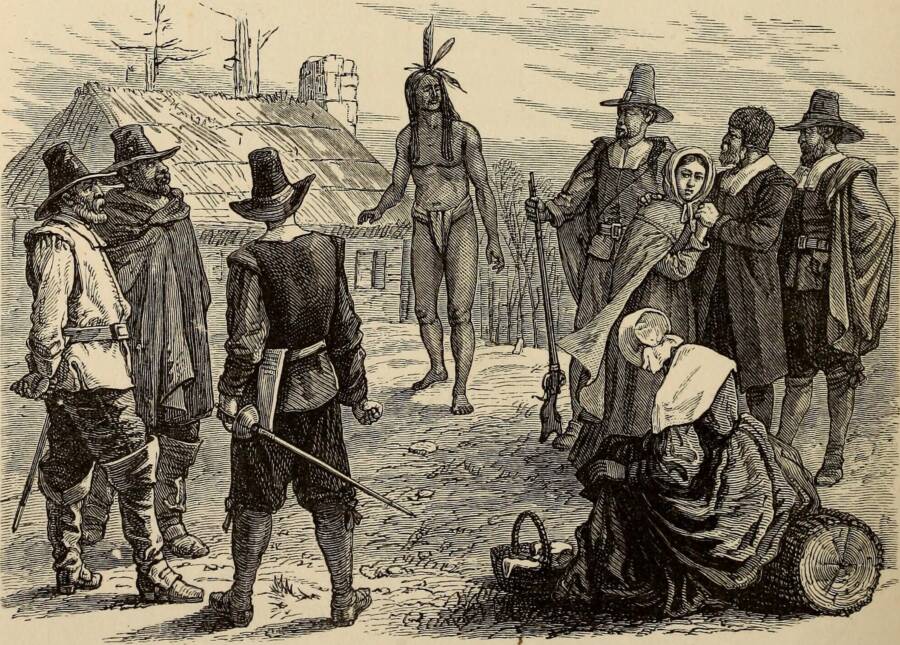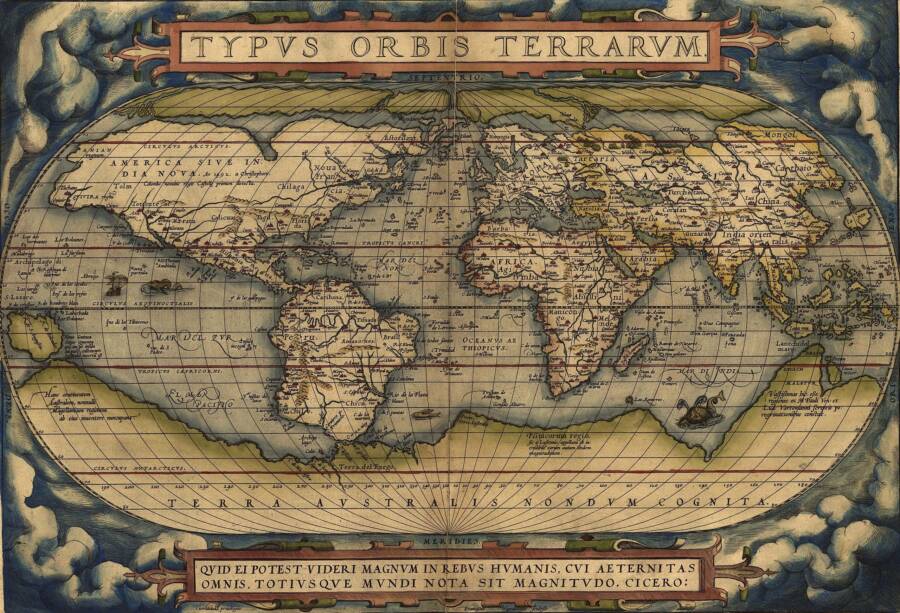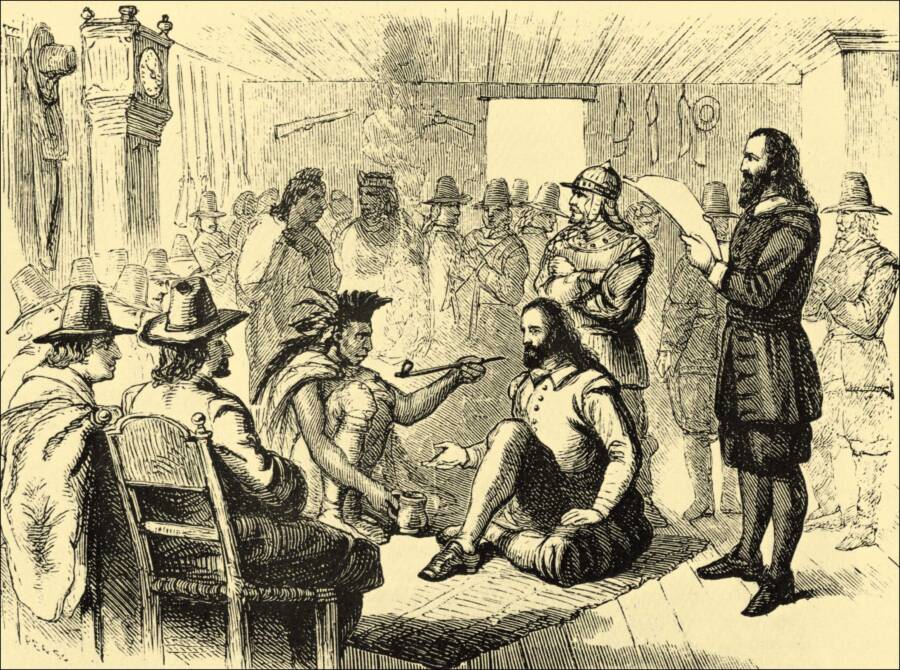Samoset was an Abenaki man who welcomed the Pilgrims at Plymouth Colony in March 1621, forging a relationship between the colonists and the Wampanoag people that ultimately led to the first Thanksgiving later that year.

Public DomainA depiction of Samoset’s first encounter with the Pilgrims.
By early 1621, the Pilgrims of Plymouth Colony were in dire straits. Half of their number had perished since their arrival the previous November, and the colony was struggling to survive. Then, one day in March, a Native American man walked straight into their midst. His name was Samoset, and he would change the course of history.
An Abenaki Native American who spoke some English, Samoset was able to communicate with the stunned colonists. He introduced himself, told them about the territory they’d landed in, and set up a meeting with Massasoit, the powerful Wampanoag chief who had sent Samoset to Plymouth.
The long and difficult history of Native Americans and white settlers grew from this first encounter. But though Samoset played a crucial role, his story is often relegated to a footnote.
Here’s everything you need to know about Samoset, the Native American who first approached the Pilgrims.
Coming Of Age In The ‘New World’
Little is known about Samoset’s early life, but by the time he was born around 1590, the world around him was undergoing massive changes.
Christopher Columbus had famously sailed to the “New World” a century before in 1492, and Europeans had been exploring North America ever since. Though few attempted to establish permanent settlements, fishing fleets from France, England, and elsewhere began sailing up and down the coast between Newfoundland and Cape Cod in the 16th century.

Public DomainA world map from the 16th century. By the time Samoset was born around 1590, Europeans had started exploring the “New World.”
This is where Samoset, who was born in present-day Maine as a member of the Abenaki tribe, started picking up English.
But though Samoset was able to establish a good relationship with the Europeans he encountered, not all Indigenous people had the same experience. Some were sold into slavery; others, like Squanto, were kidnapped and brought back to Europe.
All in all, many Native Americans learned to distrust the Europeans who had appeared on their shores. Between kidnappings, violence, and disease, the Europeans had proven that they were a serious threat.
Then, in November 1620, the Pilgrims arrived on the Mayflower.
How Samoset Made Contact With The Pilgrims
The Pilgrims had a rough start in the New World. Though they’d meant to land in Virginia, they ended up further north in Cape Cod. And during their first couple of months, as many as two or three people died per day from poor nutrition, inadequate shelter, and disease.
Forty-five people — half of those aboard the Mayflower — perished during the winter of 1620 to 1621.

Classic Image / Alamy Stock PhotoHalf of the Pilgrims perished during their first winter in the New World.
During this time, the Pilgrims also clashed with local Native Americans — who had already suffered from kidnappings and diseases at the hands of Europeans. The Pilgrims made things worse by stealing corn and other supplies, which led local tribes to retaliate.
All the while, a powerful Native American leader named Massasoit was keeping an eye on the situation. The head of the Wampanoag Confederacy, a loose confederation of Indigenous tribes, Massasoit eventually decided to try and establish friendly relations with the Pilgrims. The new arrivals, it seemed, were preparing to stay on a permanent basis. Massasoit might have felt that working with them could elevate his stature.
So, he enlisted the help of the English-speaking Samoset to establish contact with the Pilgrims. It’s unclear how Samoset ended up near Plymouth — he may have been a prisoner of Massasoit — but he seemingly agreed to the mission and set out for Plymouth Colony on March 16, 1621.

Public DomainA 19th-century depiction of Samoset meeting the Pilgrims.
The colonists describe Samoset’s arrival in Mourt’s Relation: A Journal of the Pilgrims at Plymouth (1622), writing:
“[T]here presented himself a savage, which caused an alarm. He very boldly came all alone and along the houses straight to the rendezvous, where we intercepted him, not suffering him to go in, as undoubtedly he would, out of his boldness. He saluted us in English, and bade us welcome, for he had learned some broken English among the Englishmen that came to fish at Monchiggon, and knew by name the most of the captains, commanders, and masters that usually come. He was a man free in speech, so far as he could express his mind, and of a seemly carriage. We questioned him of many things; he was the first savage we could meet withal.”
Samoset explained where he’d come from and described the area the Pilgrims had landed in. As it got colder, the Pilgrims gave Samoset a coat — he was wearing “only a leather about his waist” — as well as alcohol (“strong water”) and food. They described him as “a tall straight man, the hair of his head black, long behind, only short before, none on his face at all.”
“All the afternoon we spent in communication with him; we would gladly have been rid of him at night, but he was not willing to go,” the colonists wrote. “We lodged him that night at Stephen Hopkin’s house, and watched him.”
The next morning, Samoset left with several gifts given to him by the colonists. Massasoit’s goal had been achieved — a dialogue was open. Samoset returned the next day with five Native American warriors and then again a few days later with Squanto, who also spoke English.
On March 22, Massasoit came to Plymouth Colony himself. He and the colonists agreed to a peace treaty, and Massasoit’s friendship helped the Pilgrims survive through their difficult early years.

Public DomainMassasoit and Plymouth Colony governor John Carver smoking a peace pipe, circa 1621.
But Samoset more or less disappeared from the story.
Samoset’s Uncertain Fate After 1621
What happened to Samoset after he helped establish relations between the Pilgrims and Native Americans? Aside from accounts written by the Pilgrims, he appears in the historical record only once more. In 1624, explorer Captain Christopher Levett wrote of an encounter with Samoset in Portland, Maine.
“[H]ere I stayed four nights, in which time, there came many native people, among them [Samoset], a Sagamore,” Levett wrote, “one that has been found very faithful to the English and has saved the lives of many of our nation, some from starving, others from killing.”

Pictures Now / Alamy Stock PhotoSamoset played an important role in establishing a relationship between Native Americans and Pilgrims, but he more or less disappeared from the historical record in the aftermath.
In the years since, Samoset’s role in helping the Pilgrims survive has been generally acknowledged. (Though an 1808 play casts him in the role of a villain who attempts to abduct a virginal Pilgrim named Juliana). He is seen as an important first step in establishing a relationship between Native Americans and Pilgrims. But what did Samoset think about his role?
Without any written accounts from him, we’ll never know how he felt about his mission to Plymouth Colony, his opinions of the Pilgrims, or what happened to him in the years afterward. However, Samoset’s “bold” first encounter with the Pilgrims has not been forgotten.
After reading about Samoset, the Native American who first made contact with English settlers at Plymouth, discover the stories of nine of the most powerful Native American warriors in history. Or, go inside the complicated history of Native Americans and smallpox blankets.





